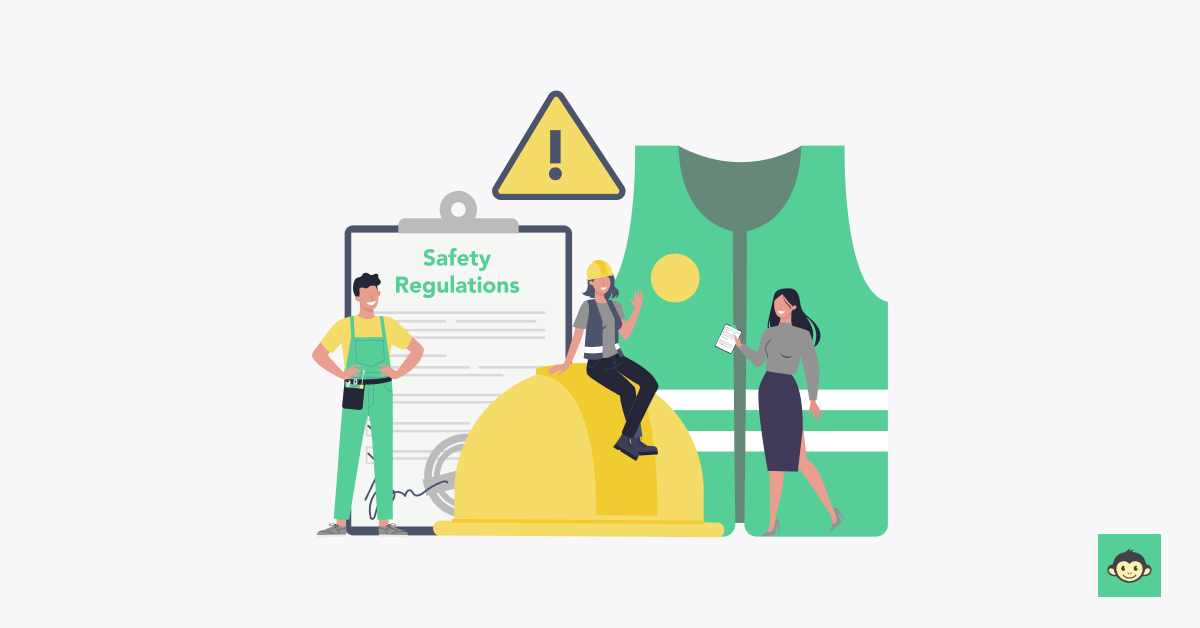What is a safe working environment: Benefits, best practices, and examples

In today's dynamic world, the significance of ensuring the well-being of employees cannot be overstated. A secure workplace not only serves as a cornerstone for a healthy, motivated workforce but also serves as a catalyst for increased productivity and an elevated corporate reputation.
In this blog, we'll embark on a journey to uncover the advantages, best practices, and practical work environment examples that epitomize a genuinely secure workplace. Join us as we delve into the realm of safety and learn how creating a safe and healthy working environment is a win-win for both employers and employees alike.
Let's dive in!
Safe working environment: Definition

So, what qualifies as a safe working environment? It's not merely about meeting legal obligations; it goes far beyond that. A safe and comfortable working environment can be defined as a sanctuary where employees perform their tasks free from potential hazards, risks, or threats to their physical and psychological well-being.
It involves diligently implementing preventive measures, comprehensive safety policies, and meticulous procedures designed to minimize workplace accidents, injuries, and illnesses. Within this sanctuary, employees can execute their duties with unwavering confidence, knowing their health and safety are uncompromised.
But the essence of a safe working environment extends further. It's about fostering a culture of care where employers take an active stance in ensuring the protection and well-being of their workforce.
It's an environment where safety isn't just a checklist item but a shared commitment, a reflection of an organization's genuine concern for its most valuable asset—its people.
Such an environment not only complies with legal regulations but also fosters a culture of care where employers prioritize and actively ensure the protection and well-being of their workforce.
Why is it important for the work environment to be safe?

A safe environment serves as the bedrock of employee well-being and operational efficiency, with far-reaching impacts on individuals and organizations. In this discussion, we'll explore why safety in the workplace is a non-negotiable priority.
Protecting lives
The most fundamental reason is the preservation of human life. Every individual has the right to go to work and return home without suffering harm. A safe environment minimizes the risk of accidents and injuries that can lead to fatalities or long-term health issues.
Employee well-being
The work environment is where employees spend a substantial portion of their lives. When this space is rife with potential hazards and risks, it can induce stress and anxiety.
The constant worry of accidents or injuries can cast a looming shadow over employees' daily experiences. This, in turn, not only affects their work performance but also seeps into their personal lives, leading to an overall decline in their quality of life.
Boosting productivity
A safe environment promotes higher productivity. Fewer accidents mean fewer disruptions and less time off work. In fact, studies show that safe workplaces have higher employee morale and performance, leading to increased productivity.
Cost savings
Workplace accidents and injuries can be costly for employers due to medical expenses, workers' compensation claims, and legal liabilities. A more safe and healthy work environment reduces these financial burdens.
Attracting talent
Companies that prioritize safety are more attractive to potential employees. Job seekers are increasingly looking for organizations that value their well-being, and a business' reputation for safety can be a competitive advantage in recruitment.
Compliance and reputation
Compliance with all safety rules and regulations is not only a legal obligation but also crucial for maintaining a positive corporate image. A strong safety record enhances an organization's reputation and can be a point of pride for employees and stakeholders.
Reducing turnover
Employees are more likely to stay with a company that takes their safety seriously. To expand on this a little, When employees leave, it necessitates recruitment and training of new staff members, which incurs significant costs both in terms of time and resources. The expenses associated with advertising job openings, conducting interviews, and onboarding new hires can quickly add up.
Legal and ethical responsibility
Employers have a moral and legal obligation under federal law to provide a safe environment for their employees. Neglecting safety can result in legal repercussions and damage to a company's integrity.
Improving employee morale
A safe work environment fosters a sense of trust and loyalty among employees towards their employers. When workers feel valued and protected, they are more likely to engage positively with their tasks and colleagues.
This positive morale can create a supportive workplace culture where employees are motivated to excel and collaborate effectively.
Enhancing innovation and creativity
Safety concerns can stifle innovation and creativity in the workplace. When employees are preoccupied with safety hazards, they may be less inclined to experiment or think outside the box.
Conversely, a safe environment encourages employees to focus their energy on problem-solving and innovation, leading to the development of new ideas and processes that drive business growth and competitiveness.
Strengthening community relations
A commitment to safety can extend beyond the workplace and positively impact the surrounding community. Companies that prioritize safety often engage in community outreach programs, safety training sessions, and initiatives to improve overall well-being.
By actively participating in community safety efforts, businesses can build trust and goodwill among residents, enhancing their reputation as responsible corporate citizens.
Ensuring business continuity
Safety measures not only protect employees but also safeguard business operations against unforeseen disruptions. Natural disasters, accidents, or health emergencies can severely impact productivity and profitability if proper safety protocols are not in place.
By proactively addressing safety concerns, businesses can minimize downtime and ensure continuity even in challenging circumstances.
Fostering sustainability
Safety practices often align with principles of sustainability and environmental responsibility. By implementing measures to reduce waste, conserve resources, and mitigate risks to health and safety, businesses can contribute to a more sustainable future.
This commitment to sustainability not only benefits the environment but also enhances the long-term viability and resilience of the organization.
Promoting mental health
A safe work environment also includes measures to support mental health. By addressing factors such as workplace bullying, harassment, and excessive stress, organizations can create a more supportive atmosphere that promotes mental well-being.
This not only enhances employee satisfaction but also reduces absenteeism and turnover, contributing to overall organizational stability.
Encouraging employee engagement
When employees feel safe and valued, they are more likely to be engaged and committed to their work. A strong safety culture fosters a sense of belonging and purpose, encouraging employees to take ownership of their roles and contribute proactively to the organization's success.
Engaged employees are more productive, innovative, and likely to stay with the company long-term.
In summary, a safe working environment is vital because it safeguards lives, improves employee health and well-being, enhances productivity, reduces costs, attracts talent, maintains legal and ethical standards, and protects a company's reputation. It's a win-win for both employees and employers.
What are three characteristics of a safe working environment?

A safe working environment is an indispensable foundation for both employees and organizations. It transcends compliance, embodying a commitment to the well-being of the workforce.
Let’s look at three pivotal characteristics of a secure workplace, where proactive hazard management, informed employees, and open communication ensure a culture of safety and success.
1. Hazard identification and mitigation
A safe working environment proactively identifies potential hazards and takes measures to mitigate or eliminate them. This involves regular risk assessments, safety inspections, and the implementation of preventive measures to reduce the likelihood of accidents and injuries.
For safety hazards for example, a manufacturing facility might conduct routine inspections to identify and fix faulty machinery or unsafe working conditions.
2. Employee safety training and awareness
In a safe working environment, employees are well informed and trained on safety procedures and practices. They are aware of potential risks and know how to respond to emergencies. Training might encompass first aid, fire safety, and specific job-related safety protocols.
An example of positive work environment is a construction company that provides comprehensive training to its workers on the proper use of personal protective equipment (PPE) and construction site safety.
3. Open communication and reporting
Encouraging open communication is a hallmark of a safe working environment. Employees should feel comfortable reporting safety concerns, near misses, or incidents without fear of reprisal. Employers should have systems in place for reporting and investigating safety issues.
For instance, a tech company might have an anonymous reporting system for employees to share safety concerns, ensuring a proactive approach to resolving potential risks.
These characteristics are essential for creating a healthy work environment where employees can perform their tasks with confidence, knowing that their well-being is a top priority.
3 Dimensions of workplace safety: Physical, psychological & digital
True workplace safety extends beyond the walls of an office—it spans body, mind, and tech. Here’s how each layer contributes to a truly safe work environment.
1. Physical safety: Building the foundation
This is where it starts—keeping people physically protected. It means clear exits, emergency plans, good lighting, and ergonomic design. Safe working conditions also include protective gear, accessible first-aid kits, and regular inspections. Safe working environment examples like clutter-free walkways, safety signage, and monitored equipment ensure every safe working area supports comfort, health, and compliance.
2. Psychological safety: Creating emotional security
A safe environment goes far beyond hard hats. Employees must feel heard, respected, and able to express concerns without fear. That’s psychological safety. Encourage open dialogue, address stress or burnout, and promote inclusion. This emotional layer is critical to a safe work environment, especially in high-pressure roles or remote teams, where isolation can quietly grow.
3. Digital safety: Protecting the virtual workspace
As hybrid and remote work continue, digital threats must be part of the safety conversation. Secure tools, multi-factor authentication, and cyber hygiene training create digital safe working conditions. Employees should know how to protect data and avoid phishing. Just like a physical safe working area, the digital workspace deserves structure, clarity, and protection.
How can you promote workplace safety?

Promoting safety in the workplace involves fostering a culture of safety and implementing foundational practices that incorporate safety. Firstly, clear and comprehensive safety policies and procedures should be established and communicated to all employees.
Regular safety training and awareness programs should be conducted to ensure that every team member understands the potential risks and knows how to mitigate them.
Additionally, management should lead by safe working environment example and prioritize worker safety. This can be achieved by integrating safety considerations into decision-making processes and providing the necessary resources to maintain a safe working environment.
Regular safety inspections, incident reporting, and feedback mechanisms should be in place to continuously improve safety measures. Moreover, recognizing and rewarding employees for their commitment to safety can reinforce the importance of safe practices.
Creating an open and non-punitive environment for reporting safety concerns is crucial. By involving employees in all safety programs and initiatives and seeking their input, a workplace can foster a collective responsibility for safety, making it a shared goal for all.
Creating physical safety: Office, remote, and hybrid work considerations
No matter where your team works—from boardrooms to bedrooms—physical safety remains non-negotiable. A truly safe work environment protects employees beyond compliance. Whether in-office, remote, or hybrid, safety must evolve with how and where people work.
Let’s break down what physical safety looks like across these three distinct yet equally important working environment meaning categories.
Office safety: The foundation of a safe work environment
In traditional offices, safe work environment examples include clear walkways, well-lit spaces, labeled emergency exits, and proper ventilation. Ergonomic furniture, secure equipment, and visible safety signage reinforce physical safety.
Regular inspections and quick fixes show care. A safe office isn’t just about avoiding hazards—it’s about showing employees their environment is thoughtfully designed for their comfort and protection.
Remote work: Redefining the working environment meaning
At home, working environment meaning shifts. Remote employees also deserve safe setups—think ergonomic chairs, safe cable management, and good lighting. Providing wellness tips and remote safety checklists shows employers care beyond office walls.
Safe work environments aren’t location-bound—they’re defined by how much effort is made to protect people, even when they work independently.
Hybrid setups: Balancing consistency across locations
Hybrid workers move between spaces, so consistency matters. Offer ergonomic tools both at home and in-office, and guide them on what’s provided where. Include what does a safe workplace looks like in a hybrid onboarding. The key is giving employees a sense of control and care across all locations. That’s what defines truly safe work environments in today’s world.
7 Safe working environment examples

From the hustle and bustle of construction sites to the precision of healthcare facilities, safe working environments are the backbone of productive and secure workspaces.
In this section, we'll explore seven real-world safe working conditions examples of industries and workplaces that have mastered the art of safeguarding their employees and creating environments where safety and well-being are paramount.
- Construction site safety: construction companies that implement strict safety protocols, provide personal protective equipment (PPE), conduct regular safety meetings, and emphasize fall protection measures to ensure the well-being of workers.
- Healthcare facilities: hospitals and clinics maintain a safe environment through rigorous infection control practices, staff training on patient handling, and stringent sanitation procedures to protect both patients and healthcare workers.
- Manufacturing plants: manufacturing facilities focus on machinery safety, lockout/tagout procedures, and proper ventilation to safeguard workers from potential hazards like machinery accidents or exposure to harmful chemicals.
- Office spaces: office environments promote safety through ergonomic workstations, fire safety measures, and awareness programs that educate employees about fire evacuation procedures and first aid.
- Agriculture and farming: farms prioritize tractor and machinery safety, as well as the use of personal protective equipment for workers handling equipment or chemicals.
- Restaurant kitchens: commercial kitchens maintain safety with proper training on the use of sharp tools, fire suppression systems, and food safety practices to reduce hazards like cuts and burns.
- Warehouses: warehouses ensure safety through proper forklift operation, storage procedures, and fall protection measures, keeping workers safe while handling goods and machinery.
These examples illustrate how different industries tailor safety measures to their specific work environments to protect employees and create secure working conditions.
Common signs of an unsafe work environment
Sometimes, it’s not flashing lights or alarms that signal danger—it’s the everyday signs we overlook that reveal cracks in safety in a work environment.
- Frequent accidents or near misses: Even if no one’s seriously hurt, a pattern of incidents indicates that safety measures may be lacking. Regular slips, trips, or equipment mishandling are red flags that your environment needs immediate attention.
- Lack of clear communication: When employees aren’t sure who to report issues to, or safety protocols are outdated or unclear, confusion takes over. Effective safety in the workplace depends on consistent, transparent communication at every level.
- Missing or inadequate safety gear: If PPE is hard to find, poorly maintained, or optional, it compromises even the most basic workplace health and safety tips. A secure work environment begins with proper tools.
- Low morale or fear of reporting: If employees feel unsafe speaking up, something’s wrong. A healthy work environment encourages openness and acts on feedback, not just collects it.
- Neglected maintenance or clutter: Overflowing storage areas, broken fixtures, or poor lighting can quickly lead to hazards. These overlooked details compromise safety in a work environment and signal deeper negligence.
- No ongoing safety training: Safety isn’t a one-and-done session. Without refresher courses or updated safety tips, employees may forget proper procedures or feel disengaged from the process.
Poor working conditions examples
Poor working conditions can severely impact employee well-being, productivity, and overall job satisfaction. Here are several examples of poor working conditions that illustrate the challenges faced by employees in various industries:
1. Inadequate safety measures
One of the most critical issues in the workplace is the lack of proper safety measures. This includes insufficient safety equipment, lack of emergency protocols, and poorly maintained machinery.
Employees working in such environments are at high risk of accidents, injuries, and long-term health issues. For example, construction sites without proper scaffolding or personal protective equipment (PPE) expose workers to significant hazards.
2. Overcrowded and unhygienic workspaces
Working in overcrowded spaces can lead to numerous problems, including increased stress levels, reduced productivity, and higher transmission rates of illnesses.
Unhygienic conditions, such as dirty restrooms, poorly maintained facilities, and lack of proper ventilation, can cause health problems and contribute to a generally unpleasant working environment.
3. Excessive work hours and unreasonable demands
Excessive work hours without adequate breaks can lead to burnout, fatigue, and mental health issues. Employees in industries such as healthcare, finance, and technology often face unrealistic deadlines and heavy workloads, resulting in chronic stress and a poor work-life balance.
4. Insufficient compensation and benefits
Poor compensation and lack of benefits such as healthcare, paid leave, and retirement plans can demotivate employees and lead to financial stress. This is especially common in low-wage sectors, where workers may struggle to meet their basic needs due to inadequate pay.
5. Lack of job security
Temporary contracts, frequent layoffs, and unstable job conditions contribute to employee anxiety and uncertainty. Workers in industries prone to economic fluctuations, such as retail and manufacturing, often face the fear of losing their jobs, which can impact their overall performance and commitment.
6. Workplace bullying and harassment
A toxic work culture where bullying, harassment, and discrimination are prevalent creates a hostile environment for employees. This can lead to emotional distress, reduced morale, and increased turnover rates. Employees subjected to such treatment often feel unsupported and undervalued.
7. Poor communication and management practices
Ineffective communication and poor management practices can lead to misunderstandings, errors, and decreased morale. Employees need clear instructions, constructive feedback, and supportive leadership to thrive. A lack of these elements can result in confusion and frustration.
8. Inadequate training and development opportunities
Without proper training and opportunities for professional growth, employees may feel stagnant and undervalued. Continuous development is essential for maintaining motivation and improving performance. A lack of investment in employee growth can lead to high turnover rates and a less skilled workforce.
15 Occupational safety environment best practices to follow

Creating a safe and productive work environment is a multifaceted endeavor, demanding continuous commitment and adherence to best practices.
In this section, we'll delve into twelve occupational safety best practices that are fundamental to preserving the well-being of employees and the success of organizations.
These practices encompass hazard management, employee training, and the cultivation of a robust safety culture, providing a comprehensive roadmap for a safer and more prosperous workplace.
- Develop a comprehensive safety policy: Create and communicate a clear safety policy that outlines the organization's commitment to safety and the responsibilities of both management and employees.
- Employee training: Provide regular and thorough training on safety procedures, hazards, and the proper use of personal protective equipment (PPE).
- Hazard assessment and control: Conduct routine hazard assessments to identify and mitigate potential risks in the workplace. Implement control measures to reduce or eliminate these risks.
- Regular safety inspections: Perform frequent safety inspections and audits to ensure compliance with safety standards and identify areas in need of improvement.
- Emergency response plan: Develop and regularly review an emergency response plan, covering procedures for fires, medical emergencies, natural disasters, and other potential crises.
- First aid and medical facilities: Ensure the availability of well-stocked first aid kits, as well as easy access to medical facilities in case of more serious injuries.
- Promote safety culture: Encourage a culture of safety where employees feel comfortable reporting safety concerns, near misses, or incidents without fear of retaliation.
- Ergonomic workstations: Design workstations to be ergonomic, reducing the risk of musculoskeletal issues and promoting employee comfort and well-being.
- Safety equipment and gear: Provide the necessary safety equipment and gear such as PPE, regular review and improvement, fire extinguishers, safety signage, and eyewash stations.
- Implement a reporting system: Establish a clear and accessible reporting system for employees to report safety hazards, incidents, or near misses. Ensure that reports are taken seriously and acted upon promptly to prevent future occurrences.
- Promote mental health awareness: Integrate mental health awareness and support into your safety programs. Offer resources and training to help employees manage stress and mental health issues, fostering a holistic approach to workplace safety.
- Regularly review and update safety protocols: Continuously evaluate and update safety protocols to reflect new regulations, technologies, and industry best practices. This proactive approach ensures that safety measures remain effective and relevant.
- Leadership involvement in safety: Ensure leaders visibly participate in safety initiatives, reinforcing that safety is a shared responsibility and a top priority.
- Incident investigation and follow-up: Investigate all incidents thoroughly, identify root causes, and apply corrective actions to prevent recurrence.
- Recognize and reward safe behavior: Implement programs to acknowledge and reward employees who actively contribute to maintaining a safe work environment.
By following these best practices to implement safety protocols, organizations can maintain a safer workplace, reduce the risk of accidents and injuries, and promote a culture of safety and well-being among employees.
What is an ergonomic work environment?

An ergonomic work environment refers to a workspace that is designed to optimize the well-being and efficiency of employees by adapting to the needs of the human body.
It involves the thoughtful arrangement of furniture, equipment, and tools to reduce physical strain and discomfort, thereby minimizing the risk of musculoskeletal disorders and enhancing overall productivity.
Key elements of an ergonomic work environment include adjustable furniture to accommodate various body sizes and postures, proper lighting to reduce eye strain and fatigue, and ergonomic tools and equipment designed to promote neutral body positions and reduce repetitive motions.
Ergonomic principles emphasize the importance of regular breaks, proper posture, and ergonomic training to educate employees on healthy work habits and self-care techniques.
By prioritizing ergonomics in the workplace, organizations can create a more comfortable and supportive environment that fosters employee health, safety, and performance.
One of the benefits of a well-designed ergonomic work environment

One significant benefit of a well-designed ergonomic work environment is the reduction of musculoskeletal disorders (MSDs) among employees. MSDs, such as back pain, neck strain, and carpal tunnel syndrome, are common ailments resulting from prolonged exposure to poor ergonomic conditions in the workplace.
By implementing ergonomic principles, organizations can mitigate the risk factors associated with MSDs and promote employee health and well-being.
Proper ergonomic design ensures that workstations are tailored to accommodate the natural movements and postures of the human body, thereby reducing the strain on muscles, tendons, and joints.
For example, ergonomic chairs with adjustable lumbar support and armrests promote proper spinal alignment and reduce the likelihood of back pain. Similarly, ergonomic keyboards and mouse devices are designed to minimize wrist strain and prevent repetitive stress injuries.
Ergonomic workstations encourage employees to adopt healthy work habits, such as taking regular breaks and practicing proper posture, which further contributes to the prevention of MSDs.
By investing in ergonomic furniture, equipment, and training programs, organizations demonstrate their commitment to employee health and safety while also potentially reducing absenteeism, healthcare costs, and workers' compensation claims associated with MSDs.
Mistakes to avoid when promoting a safe work culture
Even with the best intentions, some common missteps can undermine your efforts in promoting a safe working environment.
- Ignoring minor incidents: Brushing off near-misses or minor injuries sends the wrong message. To truly maintain safe and secure working environment standards, even small incidents should trigger investigation and learning.
- Lack of consistent communication: Failing to talk about safety regularly makes it feel like an afterthought. Safety in a work environment should be a constant conversation, not just a poster on the wall. Regular updates, reminders, and open discussions matter.
- Top-down only approach: If safety is only driven by leadership and doesn’t involve employees, it risks feeling disconnected. A healthy work environment thrives when everyone—from the intern to the CEO—feels responsible for and empowered by safety practices.
- Overlooking mental well-being: Promoting a safe working environment means going beyond physical hazards. Stress, burnout, and emotional fatigue are just as dangerous. Recognizing mental health as part of safety is critical to building trust and balance.
- Treating compliance as the goal: Focusing only on checklists or legal requirements misses the bigger picture. The importance of observing safety in a work environment lies in protecting people, not just meeting standards. Culture matters as much as compliance.
What is meant by maintaining a safe working environment?

Maintaining a safe work environment entails the consistent implementation of measures and practices aimed at safeguarding the health, well-being, and overall security of employees within the organizational setting. Here, I elucidate the key components and significance of maintaining such an environment:
- Risk assessment and mitigation: A crucial aspect of maintaining workplace safety involves conducting regular risk assessments to identify potential hazards and vulnerabilities. Once identified, appropriate measures must be taken to mitigate these risks effectively.
- Compliance with regulations: Adherence to relevant safety regulations and standards set forth by regulatory authorities is paramount. This includes compliance with occupational health and safety laws, building codes, and industry-specific guidelines to ensure a safe and compliant work environment.
- Employee training and education: Providing comprehensive training and education programs equips employees with the knowledge and skills necessary to identify hazards, respond to emergencies, and adhere to safety protocols.
- Provision of safety equipment and resources: Employers must furnish appropriate safety equipment, protective gear, and resources to mitigate risks associated with specific tasks or work environments.
- Effective communication channels: Establishing clear communication channels for reporting hazards, incidents, and concerns is essential.
- Emergency preparedness and response: Developing robust emergency preparedness plans and procedures is critical for effectively managing unforeseen events such as fires, natural disasters, or medical emergencies.
- Continuous improvement and evaluation: Regular monitoring, evaluation, and feedback mechanisms facilitate ongoing improvement of safety protocols and procedures.
- Promotion of health and wellness: Beyond physical safety, maintaining a safe working environment also encompasses promoting employee health and wellness.
- Leadership commitment and engagement: Leadership commitment to safety is instrumental in fostering a culture of accountability and prioritizing safety throughout the organization.
Safe working environment KPIs to measure and improve your work environment

Measuring and improving a safe working environment requires the use of key performance indicators (KPIs) to track progress and identify areas for enhancement. Some crucial KPIs include:
- Incident rate: Tracking the number of serious workplace injury incidents, accidents, and near-misses helps identify problem areas and measure the effectiveness of safety measures.
- Lost time injury rate: This KPI assesses the number of injuries that result in lost workdays, providing insight into the severity of workplace injuries.
- Safety compliance: Monitoring how well employees adhere to safety procedures and policies helps maintain a whole company culture and of safety.
- Training completion rate: Ensuring that employees complete safety training programs on time reflects a serious employer's commitment to their safety education.
- Safety culture surveys: Regular surveys assessing employee perceptions of workplace safety and health program, can offer valuable insights into areas that need improvement.
Importance of employee engagement committees in enforcing safe workplace policies

Employee engagement committees play a pivotal role in enforcing safe workplace policies. These committees serve as the lifeblood of a strong safety culture, bridging the gap between the workforce and management, and in doing so, creating a safer, more secure work environment.
These dedicated committees don't merely exist on paper. They are the embodiment of a workplace culture that actively values safety. By representing the voices and concerns of employees, they provide essential feedback that informs decision-making at all levels.
Through regular communication with management, they ensure that safety policies aren't just bureaucratic documents, but instead, living, breathing principles that guide daily operations.
Employee engagement committees don't just react to safety concerns; they actively promote best practices and encourage a culture of safety. Their proactive approach leads to the development of strategies that preemptively identify and mitigate potential risks.
By ensuring that safety is woven into the fabric of the workplace, these committees make safety everyone's responsibility. In essence, they transform a workplace culture from one where safety is a mere concept to one where safety is a collective commitment.
Role of anonymous employee survey tools in creating a safe workplace

Anonymous employee survey tools provide a safe platform for employees to voice their concerns, ideas, and experiences related to safety. The beauty of anonymity lies in its ability to unshroud hidden issues. By ensuring that employees' identities are protected, these survey tools encourage individuals to speak up about concerns they might otherwise keep to themselves.
As a result, organizations gain access to valuable, unfiltered insights that might have yet to surface through traditional reporting channels.
Moreover, anonymous feedback ensures that employees feel secure in reporting safety concerns without fear of retribution, fostering a transparent safety culture. They enable organizations to take the collective pulse of their workforce when it comes to safety. Are employees feeling secure, or do they have reservations about certain practices or conditions?
These insights are invaluable for making data-driven decisions aimed at enhancing safety measures.
Perhaps most importantly, anonymous feedback cultivates a transparent safety culture. Employees feel secure in reporting safety concerns without the fear of retribution. This transparency not only builds trust but also ensures that safety isn't merely a top-down directive; it becomes a collaborative effort where everyone plays a part.
In essence, anonymous employee survey tools empower employees to be vocal champions of safety, driving positive change and contributing to the creation of a genuinely secure work environment.
Conclusion
Maintaining a safe working environment is not only a legal and moral obligation but a cornerstone of a productive and harmonious workplace. Key performance indicators, employee engagement committees, and anonymous surveys are invaluable tools to assess, enhance, and ensure safety in the workplace.
For further insights into building a safe and thriving workplace culture, we recommend exploring CultureMonkey, a platform specializing in employee engagement and workplace culture improvement.
FAQs
1. What are the essential elements of a safe working environment?
A safe working environment is one that is a harmonious blend of essential components, including vigilant hazard identification, well-defined safety policies, continuous employee training, routine safety inspections, robust emergency response plans, and a pervasive culture of safety. Together, these elements come together to create a shield that guarantees the safeguarding and well-being of every individual within the workplace.
2. How can I report safety concerns at my workplace anonymously?
To anonymously report safety concerns at your workplace, organizations have mechanisms to do so. They often provide dedicated channels like hotlines or online reporting tools. These silent mechanisms allow employees to express their worries, observations, or potential hazards without disclosing their identity, fostering a culture of open and confidential communication, which is important for smooth functioning.
3. What role do safety committees play in maintaining a safe working environment?
Safety committees are the linchpins in sustaining a safe workplace for its employees. They actively involve employees in critical safety decisions, diligently review and update safety policies, and ardently advocate for the perpetual enhancement of safety standards. These committees effectively orchestrate a collective endeavor towards ensuring the safety and well-being of every member within the organization.
4. How often should safety training be conducted in a workplace?
The frequency of safety training in a workplace is contingent on various factors, like adherence to industry standards, the dynamic nature of workplace hazards, compliance with health and safety regulations, and the continuous integration of new employees. Regular safety training sessions are imperative, ensuring employees remain well-prepared and fully informed to address ever-evolving workplace risks and emergency scenarios.
5. What are the consequences of not maintaining a safe working environment?
Failing to maintain a safe working environment can result in severe consequences for organizations. Some consequences include workplace accidents, injuries, legal penalties, damage to a company's reputation, and a decline in overall employee morale and productivity. It is imperative for organizations to prioritize safety to mitigate these adverse outcomes and ensure a secure and productive work environment.
6. What makes a workplace truly “safe”?
A truly safe workplace environment goes beyond hard hats and warning signs. It blends physical safety measures with emotional well-being, strong safety management, and clear communication. Safe working conditions, proper equipment, and an inclusive culture all contribute. Ultimately, the importance of safety in a work environment lies in how consistently people feel protected, valued, and heard.
7. What are the psychological aspects of a safe work environment?
A safe environment includes mental and emotional security. Employees should feel they can speak up without fear, take breaks without guilt, and access support when stressed. Safe working environment examples include mental health resources, clear boundaries, and zero tolerance for harassment—elements that reinforce the importance of safe working environment values across every level.
8. How can HR promote emotional safety in remote teams?
HR can foster a safe working area online by setting transparent communication norms, encouraging regular check-ins, and offering mental wellness support. Virtual workplace health and safety tips—like encouraging screen breaks or stress-reducing routines—enhance safety in the workplace, even remotely. Prioritizing empathy and digital inclusion supports both productivity and a psychologically safe work environment.
9. What individual responsibility could you show to ensure a safe and healthy environment?
Individuals play a key role in workplace safety. Reporting hazards, following protocols, and supporting peers builds a safe working environment. Practicing good ergonomics, hygiene, and stress management are simple yet powerful safety tips. Whether it's flagging issues or modeling respect, personal accountability reinforces the collective importance of safety in a work environment.
9. What are the workplace safety communication tips?
- Use clear, simple language to explain protocols, crucial for how to create a safe work environment.
- Share real stories, including unsafe work environment examples, to make risks relatable.
- Encourage two-way feedback so employees feel heard.
- Use visual cues like signage or infographics.
- Reinforce with examples of safe environment practices in action.



